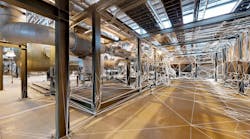How can you justify the time and expense of an organization-wide digital transformation when you can't really measure the most important benefits?
Jerry Grunewald, vice president of operations transformation at advanced materials manufacturer Invista, runs the Koch Industries subsidiary’s Industry 4.0 initiatives. Invista manufactures materials such as nylon and polypropylene and employs around 3,000 workers at 13 sites globally.
Invista’s ops transformation program began in late 2018 as Grunewald targeted four workstreams:
· Process control
· Asset performance management
· Material flow automation
· Learning and development.
The plan was to pilot separate technologies for each workflow and then weave the technologies together into a unified, connected worker system.
While the final product improved operational efficiency, that’s ultimately not the point nor the long-term goal.
“If we bring all these [IoT] tools to bear and fundamentally do the job the way we’ve always done it, maybe just a little bit better, that’s not transformation. That’s incremental improvement at best. [But] if you have the new knowledge, you can hopefully now do different work, do things that weren’t possible before. If you can do that, then you get the last piece, which is transformative value,” he says.
Setting the Transformation Stage
Grunewald’s vision of the connected worker included instant access to real-time sensor and process data such as temperatures and pressures, humidity, equipment vibration and corrosion levels from across the plant. Operators could access historical maintenance logs or view ideal operating parameters drawn from a machine’s engineering design schematics–all on a smartphone or tablet.
Grunewald knew it would be tricky to simultaneously develop multiple, unrelated systems for different workstreams but the first dimension of principle-based management at Koch Industries is vision, he says. It also helps when word had long since come down from on high that innovation was no longer just a choice.
“Mr. Koch, in the company newsletter in late 2017 wrote an article called ‘The Change Imperative,’ saying we are not moving fast enough, the digital transformation is here, it’s real and if we don’t do this, the actual quote is, ‘We’re going to end up in the dumpster.’ And so it was really a push to his direct reports, the CEOs of all the companies, saying you guys ain’t getting it, you’re not moving fast enough.”
He chose to keep the central ops transformation team small, and focused on identifying site transformation leaders at plants, the early adopters with the enthusiasm to drive change. Dealing with the middle layer, like first line supervisors, proved challenging. The best operator or mechanic may in the past have served well as a first line operator or supervisor. For a technology implementation, however, leadership can trump skill.
“If your [first line operators and supervisors] see their job as telling people the way they know how to do something, you will not be successful in digital transformation. You don’t want them to be the supervisor of the team that’s going to learn all these new skills, because [those first line operators and supervisors] are actually going to hold the team back,” Grunewald says.
“If you get the right first line supervisor in there who’s functioning as a coach, bringing out innate abilities, building the comparative advantage with a whole team, you can really unlock a surprising amount of skills and ability and power. Sometimes the key to change management is to change management,” he adds.
Targeting separate workstreams meant identifying the correct plants at which to pilot different technology solutions in 2019. Plants with a standing need for a new system or that had already installed enabling technologies made for best candidates.
A plant struggling to train new operators quickly matched with pilots for augmented reality/virtual reality training technology, for example. Downstream polymer and fiber plants that heavily leveraged robots, cobots and vision systems made prime testing ground for new material flow automation tools.
Grunewald acknowledges the danger of running many separate pilots at individual facilities.
“It still does drive me insane at times where a plant will say well, that’s great, that [system] worked in [another] plant, we are now going to do a pilot at our plant? And my immediate answer is no, you’re going to adopt. … We already know it works. Now, we have to figure out how to adopt it for you.”
Grunewald's Transformation Advantages
Grunewald had a few aces up his sleeve to help complete the challenging project. Access to sister Koch Industries companies Georgia-Pacific and Molex helped him identify successful technology implementations at their plants and share knowledge. He had personally worked at all 13 Invista sites and was familiar with their processes, which helped identify the best plants for different pilots.
All of Invista’s global sites had already adopted industrial wireless, a key enabling technology for IoT-based systems generally and connected worker technology specifically.
Finally, Grunewald had previously led Invista’s R&D organization and was able to tap employees from the company’s operational excellence group that included maintenance reliability specialists, process technical specialists and historical process control experts.
Even the Best Tools Should Be Choices
In 2021, Invista procured a number of lidar-based cameras from Matterport, a company that specializes in creating virtual replicas of property layouts. Invista used the cameras to map some of their manufacturing facilities and create digital twins.
Matterport’s software features a tagging tool for creating points of interest on an image and attaching data to those tags. In the case of a real estate listing, it might be details about countertops or floors. Operators repurposed that tool to add information about the plant’s equipment. Grunewald’s team then created an HMI called the Matterport Augmented Reality App (MARA) that allows operators to view equipment through smart devices and in augmented reality see all the information gathered about that equipment by the plant’s IoT network.
Excited by the pilot program but knowing they needed help to operationalize and scale MARA, Invista turned to Amazon Web Services, a partner in several other digital transformation efforts. Amazon saw the potential and the three companies jointly created AWS IoT TwinMaker with Invista serving as a de facto beta developer.
But, even with a solution successful enough to expand outside the company, Grunewald thinks technology adoption generally must revolve around choices, not mandates.
“We want every site to have TwinMaker and use it where they see the most value. There’s a collection of principles and tools, a framework, but it’s not a cookie cutter here’s the recipe and exactly do this. If a site is not [using the technology at all] and they say ‘We don’t believe this works for us,’ we’re going to say ‘We think you ought to look at that again,’” Grunewald says.
“We want them to be aware of what’s possible and to implement on a timeframe that enables them to create value. You have to be careful with your metrics. … see how these tools can help you get to a place that you couldn’t get to before,” he adds.
Transformation is a Long-Term Bet and Commitment
Quantitative and qualitative benefits–decreased unplanned downtime and increased OEE, increased production numbers, scrap reduction,–provide definitive proofs of successful manufacturing technology deployments and Grunewald has the evidence.
“Ten years ago, when I was in the plants, if you were to go out in the field and see some mechanics doing work, they were probably working on something that broke last night. Now, ideally… they’re making an adjustment on something that will prevent it from breaking two weeks from now.”
In 2018, Invista announced the construction of a new plant in Shanghai, China, the first greenfield plant constructed since the 1980s and Invista’s single largest investment in history. Thanks to travel restrictions owing to the COVID pandemic, the experts from Invista sites around the world who normally would have been on site to get the new plant online weren’t. If not for the remote assistance tools developed during Invista’s transformation initiative, it’s unlikely the plant would have gone into production in November 2022.
“Less maintenance costs, more production and higher yields, we have evidence of that, absolutely we have evidence of that. … You can show that we can start units up in hours versus days, we can train somebody in days versus months…you can put value on that and it is meaningful. [Cost savings and gains] that are multiples of what we’ve spent,” he says.
Grunewald considers these measurable benefits important but they don’t represent Invista’s transformation goals. He also doesn’t think manufacturers ought to consider technology adoptions as successes or failures based on results even a year or two after implementation.
“When we [installed] industrial wireless across our sites, it’s a couple million dollars at every site, particularly the large sites. … Historically, we would have gone to each of those sites and had them, in a very detailed Excel spreadsheet, show a profit and loss statement of how they were going to create value. But if something’s truly transformational, and it’s going to enable you to do things you couldn’t do before, it’s very hard to fill that spreadsheet out,” he says.
For instance, there’s the ‘gray wave,’ the large number of retirements expected in the manufacturing sector, combined with the expectation that new employees may not follow the historical pattern of remaining with a company for two decades or more. Manufacturers must develop institutional knowledge with new tools like with XR for learning and knowledge capture.
“I can have an operator, a good, solid learner with two years of unit experience … but because of all these tools brought together, they’ve got the implied knowledge of the person that’s worked in that area for 35 years. It is a key aspect of that broader learning imperative of how we’re going to embed knowledge into the system. That’s really important to us, something we’re facing, something that everybody who enters industry is facing.”
When the results of that technology initiative could last decades, assessment of short-term results feels less relevant.






